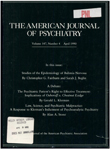The heterogeneity of schizoaffective disorder: implications for treatment
Abstract
Until the 1970s, schizophrenia tended to be broadly defined in the United States, and the diagnosis subsumed patients who had affective as well as schizophrenic symptoms. With the introduction of lithium, however, manic-depressive illness became susceptible to treatment and gained attractiveness as a diagnosis. The ambiguous position of patients with schizoaffective disorder became clear. Cross-sectionally they were seen to resemble schizophrenic patients, but longitudinally they were more akin to patients with affective disorder. Numerous studies have attempted to establish that they are diagnostically distinct, but without clear results. The authors suggest that schizoaffective disorder is heterogeneous and that its treatment should be determined by specific indices as to its subtype.
Access content
To read the fulltext, please use one of the options below to sign in or purchase access.- Personal login
- Institutional Login
- Sign in via OpenAthens
- Register for access
-
Please login/register if you wish to pair your device and check access availability.
Not a subscriber?
PsychiatryOnline subscription options offer access to the DSM-5 library, books, journals, CME, and patient resources. This all-in-one virtual library provides psychiatrists and mental health professionals with key resources for diagnosis, treatment, research, and professional development.
Need more help? PsychiatryOnline Customer Service may be reached by emailing [email protected] or by calling 800-368-5777 (in the U.S.) or 703-907-7322 (outside the U.S.).



